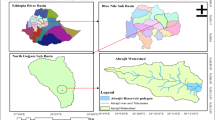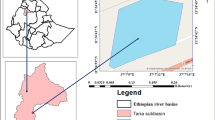Abstract
This particular examination was led on the Abrajit reservoir in the North Gojjam sub-basin, Blue Nile basin, Ethiopia. The overall target of the examination was to explore the supply siltation and assurance of the current stockpiling limit of the repository utilizing ArcGIS 10.5 variant and Golden surfer 16 most recent rendition. A bathymetric study utilizing reverberation sounding gear (Garmin GPSMAP421s) was directed for appraisal of present-day impoundment of the repository, and a pre-impoundment geographical guide of the store was inferred by digitizing existing geological guide utilized during dam development. Bathymetric differencing was utilized to explore and measure the circulation and gauge volumes of kept residue, long haul normal yearly silt motions, and remaining water stockpiling limit. The consequence of the examination uncovered that to date, 343,700.1 m3 volume of residue was amassed in the supply that decreases 20% of the complete store limit. Results from the bathymetric examination and programming investigation, every year a sum of 28,641.675 m3 year−1 measure of residue is keeping to the supply that contributed 1.66% of yearly repository volume decrease. This was determined by partitioning the aggregated volume of residue to the past worked year of the repository by considering a similar measure of dregs that have been storing in each working year. The deliberate late putting-away limit with respect to the Abrajit Dam was determined by taking away the assessed cumulative silt volume from the plan stockpiling of the repository, and it is 1,388,870 m3. From a correlation of residual repository stockpiling and yearly dregs load, the store would not serve over 12 years. The evaluated explicit residue yield was seen as 4733.387 ton km−2 year−1. In this manner, to improve the evaluated life range of supply watershed the executives are significant and further examination is required to recognize the region where watershed protection will concentrate on what’s to come. Upon the discoveries, the store volume is rushing to decrease and it cannot serve all the interest what it intended for during the dry season. Therefore, activity bends ought to be required to give water administration for the basic water needs, and regular observing of silt gathering in the store is suggested.






Similar content being viewed by others
Explore related subjects
Discover the latest articles and news from researchers in related subjects, suggested using machine learning.Change history
03 November 2020
The article [Examining Reservoir Sedimentation and Estimating Dam Stockpiling Limit Utilizing Bathymetry Overview: A Contextual Investigation of Abrajit Dam, North Gojjam Sub-basin, Blue Nile basin, Ethiopia], written by [Mekash Shiferaw and Roman Abebe], was originally published electronically on the publisher’s internet portal (currently SpringerLink) on [5th September 2020] with open access.
References
Brown, C. B. (1943). Discussion of sedimentation in reservoirs by J. Witizig (pp. 1493–1500). Washington, DC: American Society of Civil Engineers.
Chomba, I. C., & Sichingabula, H. M. (2016). Sedimentation and its effects on selected small dams east of Lusaka, Zambia sedimentation and its effects on selected small dams east of Lusaka, Zambia. Modern Environmental Science and Engineering, 1(6), 325–340. https://doi.org/10.15341/mese(2333-2581)/06.01.2015/007.
County, F. (2010). Water volume and sediment accumulation in Lake Linganore, Frederick County, Maryland, 2009.
Dagnew, D. C. (2015). Impact of conservation practices on runoff and soil loss in the sub-humid Ethiopian Highlands: The Debre Mawi watershed. Journal of Hydrology and Hydromechanics, 63(3), 210–219. https://doi.org/10.1515/johh-2015-0021.
Dumanski, J., & Pieri, C. (2000). Land quality indicators: Research plan. Agriculture, Ecosystems & Environment, 81(2), 93–102.
Gill, M. A. (1979). Sedimentation and useful life of reservoirs. Journal of Hydrology, 44(1–2), 89–95.
Haregeweyn, N. (2012). Reservoir sedimentation and its mitigating strategies: A case study of Angereb reservoir (NW Ethiopia). Journal of Soils and Sediments, 12(2), 291–305.
Jauhari, V. P. (1999). Operation, monitoring and decommissioning of large dams in India. Cape Town: World Commission on Dams.
Lal, R. (1994). Soil erosion research methods. Boca Raton: CRC Press.
Lawrence, P. (2004). Sedimentation in small dams Development of a catchment characterization and sediment yield prediction procedure (January).
Li, J., & Heap, A. D. (2011). Ecological Informatics: A review of comparative studies of spatial interpolation methods in environmental sciences—Performance and impact factors. Ecological Informatics, 6(3–4), 228–241. https://doi.org/10.1016/j.ecoinf.2010.12.003.
Minear, J. T., & Kondolf, G. M. (2009). Estimating reservoir sedimentation rates at large spatial and temporal scales: A case study of California. Water Resources Research. https://doi.org/10.1029/2007WR006703.
Mitiku, H., & Karl Herweg, B. S. (2006). Sustainable land management: A new approach to soil and water conservation in Ethiopia.
Moges, M. M., Abay, D., & Engidayehu, H. (2018). Investigating reservoir sedimentation and its implications to watershed sediment yield: The case of two small dams in data-scarce upper Blue Nile Basin, Ethiopia. Lakes & Reservoirs: Research & Management, 23(3), 217–229. https://doi.org/10.1111/lre.12234.
Mulu, A., & Dwarakish, G. S. (2015). Different approach for using trap efficiency for estimation of reservoir sedimentation. An overview. Aquatic Procedia, 4, 847–852. https://doi.org/10.1016/j.aqpro.2015.02.106.
NDEP. (2004). Guidelines for Digital Elevation Data (Version 1.0).
Rakhmatullaev, S. (2012). Sedimentation of reservoirs in Uzbekistan: a case study of the Akdarya Reservoir, Zerafshan River Basin To cite this version: HAL Id: insu-00617806 Sedimentation of reservoirs in Uzbekistan: a case study of the Akdarya Reservoir, Zerafshan River Bas.
Schleiss, A. J. (2016). Reservoir sedimentation. Journal of Hydraulic Research, 54(6), 595–614. https://doi.org/10.1080/00221686.2016.1225320.
Verstraeten, G., & Poesen, J. (2000). Estimating trap efficiency of small reservoirs and ponds: Methods and implications for the assessment of sediment yield. Progress in Physical Geography, 24(2), 219–251.
Verstraeten, G., & Poesen, J. (2001). Factors controlling sediment yield from small intensively cultivated catchments in a temperate humid climate. Geomorphology, 40(1–2), 123–144.
Zandbergen, P. A. (2008). Positional accuracy of spatial data: Non-normal distributions and a critique of the national standard for spatial data accuracy. Transactions in GIS, 12(1), 103–130.
Author information
Authors and Affiliations
Corresponding author
Ethics declarations
Conflict of interest
We (authors) have to declare that we have no known competing financial interests or personal relationships that could have appeared to influence the work reported in this paper.
Additional information
Publisher's Note
Springer Nature remains neutral with regard to jurisdictional claims in published maps and institutional affiliations.
The original online version of this article was revised due to retrospective Open Access cancellation.
About this article
Cite this article
Shiferaw, M., Abebe, R. Examining Reservoir Sedimentation and Estimating Dam Stockpiling Limit Utilizing Bathymetry Overview: A Contextual Investigation of Abrajit Dam, North Gojjam Sub-basin, Blue Nile basin, Ethiopia. J Indian Soc Remote Sens 48, 1313–1323 (2020). https://doi.org/10.1007/s12524-020-01159-8
Received:
Accepted:
Published:
Issue Date:
DOI: https://doi.org/10.1007/s12524-020-01159-8




